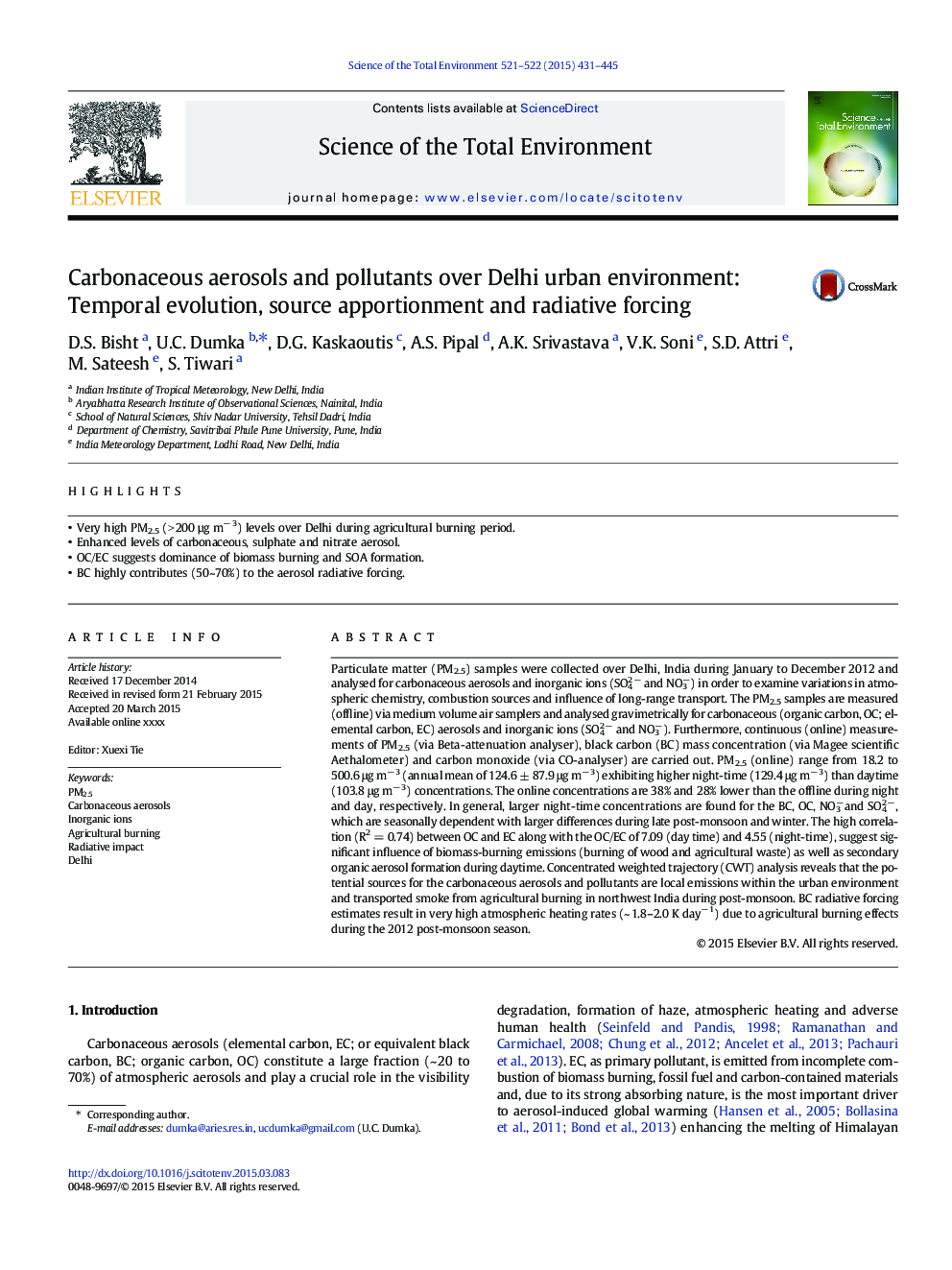| کد مقاله | کد نشریه | سال انتشار | مقاله انگلیسی | نسخه تمام متن |
|---|---|---|---|---|
| 6326637 | 1645536 | 2015 | 15 صفحه PDF | دانلود رایگان |
عنوان انگلیسی مقاله ISI
Carbonaceous aerosols and pollutants over Delhi urban environment: Temporal evolution, source apportionment and radiative forcing
ترجمه فارسی عنوان
آلیزهای کربنیک و آلاینده های محیطی شهر دهلی: تکامل موقتی، تقسیم بندی منبع و مجبور شدن تابش
دانلود مقاله + سفارش ترجمه
دانلود مقاله ISI انگلیسی
رایگان برای ایرانیان
کلمات کلیدی
موضوعات مرتبط
علوم زیستی و بیوفناوری
علوم محیط زیست
شیمی زیست محیطی
چکیده انگلیسی
Particulate matter (PM2.5) samples were collected over Delhi, India during January to December 2012 and analysed for carbonaceous aerosols and inorganic ions (SO42 â and NO3â) in order to examine variations in atmospheric chemistry, combustion sources and influence of long-range transport. The PM2.5 samples are measured (offline) via medium volume air samplers and analysed gravimetrically for carbonaceous (organic carbon, OC; elemental carbon, EC) aerosols and inorganic ions (SO42 â and NO3â). Furthermore, continuous (online) measurements of PM2.5 (via Beta-attenuation analyser), black carbon (BC) mass concentration (via Magee scientific Aethalometer) and carbon monoxide (via CO-analyser) are carried out. PM2.5 (online) range from 18.2 to 500.6 μg mâ 3 (annual mean of 124.6 ± 87.9 μg mâ 3) exhibiting higher night-time (129.4 μg mâ 3) than daytime (103.8 μg mâ 3) concentrations. The online concentrations are 38% and 28% lower than the offline during night and day, respectively. In general, larger night-time concentrations are found for the BC, OC, NO3âand SO42 â, which are seasonally dependent with larger differences during late post-monsoon and winter. The high correlation (R2 = 0.74) between OC and EC along with the OC/EC of 7.09 (day time) and 4.55 (night-time), suggest significant influence of biomass-burning emissions (burning of wood and agricultural waste) as well as secondary organic aerosol formation during daytime. Concentrated weighted trajectory (CWT) analysis reveals that the potential sources for the carbonaceous aerosols and pollutants are local emissions within the urban environment and transported smoke from agricultural burning in northwest India during post-monsoon. BC radiative forcing estimates result in very high atmospheric heating rates (~ 1.8-2.0 K dayâ 1) due to agricultural burning effects during the 2012 post-monsoon season.
ناشر
Database: Elsevier - ScienceDirect (ساینس دایرکت)
Journal: Science of The Total Environment - Volumes 521â522, 15 July 2015, Pages 431-445
Journal: Science of The Total Environment - Volumes 521â522, 15 July 2015, Pages 431-445
نویسندگان
D.S. Bisht, U.C. Dumka, D.G. Kaskaoutis, A.S. Pipal, A.K. Srivastava, V.K. Soni, S.D. Attri, M. Sateesh, S. Tiwari,
